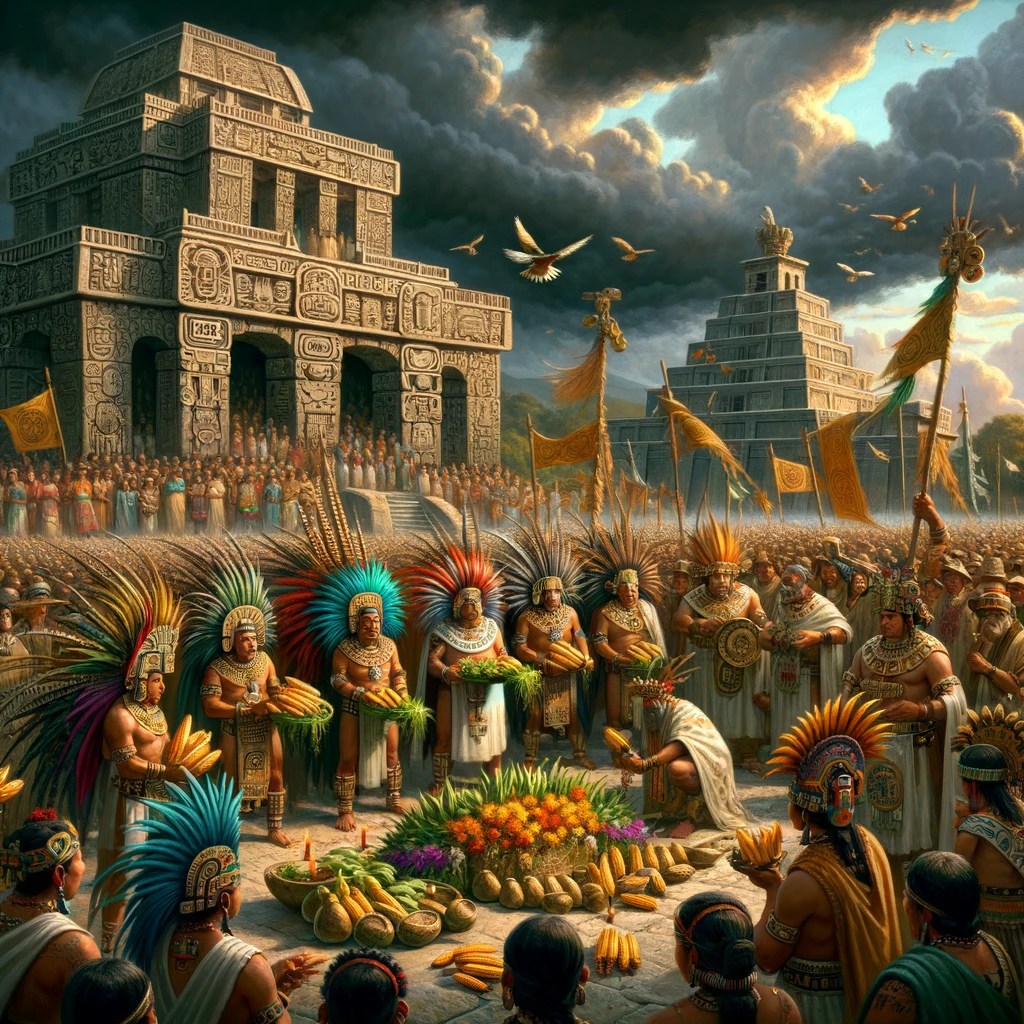
In the heart of ancient Mesoamerica, amidst the bustling streets of Tenochtitlan, the Aztec capital, there existed a sacred festival that epitomized the reverence for life's sustenance: the Atemoztli festival. Rooted in the deep spiritual connection between the Aztec people and the water gods, this vibrant celebration marked the end of the agricultural year, while fervently petitioning for the blessings of rain upon the parched earth.
The Aztec civilization thrived in a region where the balance between water and land was essential for survival. Understanding the vital role water played in their agrarian society, the Aztecs dedicated the Atemoztli festival to Tlaloc, the god of rain and fertility, and his consort Chalchiuhtlicue, the goddess of water. The festival, observed at the end of the dry season, served as a poignant reminder of the cyclical nature of life and the interconnectedness of humanity and the natural world.
Preparations for the Atemoztli festival commenced weeks in advance, with meticulous planning and elaborate rituals. Priests, adorned in ceremonial attire, led the populace in purifying ceremonies, offering prayers and sacrifices to appease the water gods. Captivating processions wound through the streets, accompanied by music, dance, and the rhythmic beat of drums, invoking divine favor for abundant rainfall and bountiful harvests.
Central to the Atemoztli festivities were the symbolic offerings made to Tlaloc and Chalchiuhtlicue. Priests and commoners alike presented intricately crafted effigies, adorned with vibrant feathers, flowers, and precious stones, symbolizing the beauty and abundance that water bestowed upon the earth. These offerings, imbued with profound spiritual significance, served as expressions of gratitude and supplication, seeking the benevolence of the water deities.
The climax of the Atemoztli festival was marked by a grand ceremony held at the Templo Mayor, the sacred precinct of Tenochtitlan. Here, amidst towering pyramids and intricately carved altars, the Aztec elite and commoners gathered to witness the culmination of their devotion. Priests conducted elaborate rituals, invoking the presence of Tlaloc and Chalchiuhtlicue through sacred chants and incantations, beseeching them to bestow their blessings upon the land.
As the sun dipped below the horizon, signaling the end of the ceremony, the fervent prayers of the Aztec people reverberated through the air. Faces upturned towards the heavens, hearts filled with hope, they awaited the promise of rain, the lifeblood of their civilization. And as if in response to their entreaties, dark clouds would gather on the horizon, heralding the arrival of the much-awaited deluge, a testament to the enduring faith of the Aztec people and the power of their collective devotion.
The legacy of the Atemoztli festival endures to this day as a testament to the profound reverence the Aztec civilization held for the forces of nature. In celebrating the life-giving properties of water, the festival served as a poignant reminder of humanity's intrinsic connection to the natural world and the importance of living in harmony with it. As we reflect on the traditions of ancient Mesoamerica, may we draw inspiration from the Atemoztli festival to cultivate a deeper appreciation for the precious gift of water and our responsibility to safeguard it for generations to come.
The Aztec civilization thrived in a region where the balance between water and land was essential for survival. Understanding the vital role water played in their agrarian society, the Aztecs dedicated the Atemoztli festival to Tlaloc, the god of rain and fertility, and his consort Chalchiuhtlicue, the goddess of water. The festival, observed at the end of the dry season, served as a poignant reminder of the cyclical nature of life and the interconnectedness of humanity and the natural world.
Preparations for the Atemoztli festival commenced weeks in advance, with meticulous planning and elaborate rituals. Priests, adorned in ceremonial attire, led the populace in purifying ceremonies, offering prayers and sacrifices to appease the water gods. Captivating processions wound through the streets, accompanied by music, dance, and the rhythmic beat of drums, invoking divine favor for abundant rainfall and bountiful harvests.
Central to the Atemoztli festivities were the symbolic offerings made to Tlaloc and Chalchiuhtlicue. Priests and commoners alike presented intricately crafted effigies, adorned with vibrant feathers, flowers, and precious stones, symbolizing the beauty and abundance that water bestowed upon the earth. These offerings, imbued with profound spiritual significance, served as expressions of gratitude and supplication, seeking the benevolence of the water deities.
The climax of the Atemoztli festival was marked by a grand ceremony held at the Templo Mayor, the sacred precinct of Tenochtitlan. Here, amidst towering pyramids and intricately carved altars, the Aztec elite and commoners gathered to witness the culmination of their devotion. Priests conducted elaborate rituals, invoking the presence of Tlaloc and Chalchiuhtlicue through sacred chants and incantations, beseeching them to bestow their blessings upon the land.
As the sun dipped below the horizon, signaling the end of the ceremony, the fervent prayers of the Aztec people reverberated through the air. Faces upturned towards the heavens, hearts filled with hope, they awaited the promise of rain, the lifeblood of their civilization. And as if in response to their entreaties, dark clouds would gather on the horizon, heralding the arrival of the much-awaited deluge, a testament to the enduring faith of the Aztec people and the power of their collective devotion.
The legacy of the Atemoztli festival endures to this day as a testament to the profound reverence the Aztec civilization held for the forces of nature. In celebrating the life-giving properties of water, the festival served as a poignant reminder of humanity's intrinsic connection to the natural world and the importance of living in harmony with it. As we reflect on the traditions of ancient Mesoamerica, may we draw inspiration from the Atemoztli festival to cultivate a deeper appreciation for the precious gift of water and our responsibility to safeguard it for generations to come.